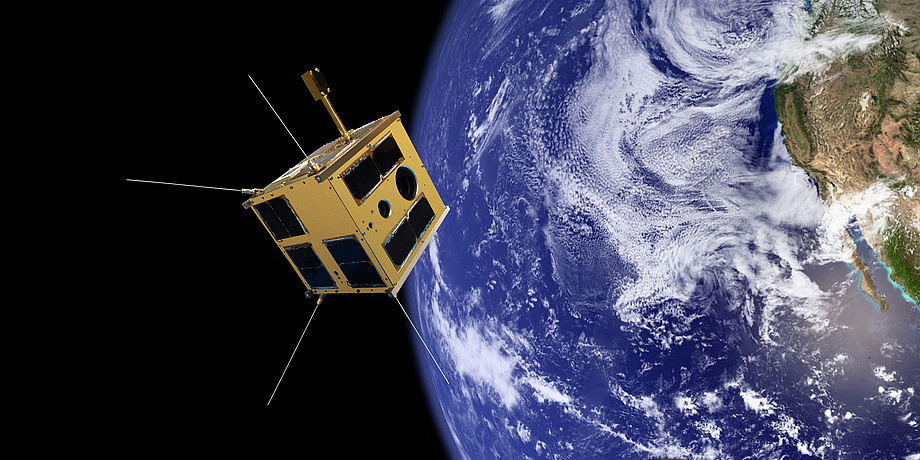The first Austrian satellite has now been in orbit for ten years. On 25 February 2013, TUGSAT-1 made its journey into space aboard a launch vehicle that took off from Satish Dhawan Space Center in India. It travelled alongside its sister satellite UniBRITE from the University of Vienna, which was released a few minutes after TUGSAT-1. Given that its planned mission duration was only two years, TUGSAT-1’s longevity has far exceeded original expectations. The satellite was developed and built at TU Graz by a team led by Otto Koudelka, the now retired head of the university’s Institute of Communication Networks and Satellite Communications. Manuela Wenger (formerly Unterberger), the project’s systems engineer, still keeps a watchful eye on the nanosatellite as a senior scientist at the institute.
TUGSAT-1 was one of five nanosatellites that formed the BRITE Mission, and can be thought of as a counterpart to large space telescopes such as Hubble or James Webb. The large telescopes can see very far into space and record images of extremely faint objects, while TUGSAT-1 with its 17cm telescope is designed to look at nearby stars, which, as they are so bright, would result in overexposed images if captured by Hubble or James Webb. The scientific data from this observation of nearby stars has led to some exciting insights and discoveries. “We didn’t previously know that Orion has some stars that pulsate with a kind of heartbeat. And in 2017, along with the other members of the BRITE network, we observed a nova from build-up right through to the explosion. That was a really breathtaking moment, because the data showed what a nova really looks like,” explained Manuela Wenger.
First contact 30 seconds to soon
The first contact with TUGSAT-1 after it had reached its orbit at about 780km above the Earth’s surface produced another exciting moment. Manuela Wenger was sitting in a specially equipped ground station at TU Graz’s Inffeldgasse campus with a colleague, waiting to relay the good news to a packed lecture theatre where the launch party was taking place a few floors below. “We had a countdown running, and knew exactly when the satellite was due to pass over the horizon. We were glued to the clock, and 30 seconds before the calculated contact time the signal just appeared. We didn’t know what was going on and just told everyone ‘We have contact’,” recalled Wenger.
Two more years of data
Ten years on and TUGSAT-1 is still providing data, but it is beginning to show its age. The batteries are no longer performing as they once did, and when relatively little solar energy can be generated in the winter months the satellite has to be shut down for a short time. The imaging equipment is also a bit worse for wear after so much exposure to space radiation, meaning that the quality of the data has deteriorated. Nevertheless, Manuela Wenger hopes that TUGSAT-1 will continue to send data for another two years, and now works on the project mainly out of personal interest, as the funding has expired.
In any case, the satellite is nearing the end of its life, when it will undergo a controlled shutdown. It will be a poignant day for Manuela Wenger, but she will have many fond memories to look back on: “Of course it’ll be sad, but we’ll definitely be able to say that TUGSAT-1 has gone above and beyond the call of duty. We’ll just have to come to terms with the fact that we’ve reached the end of the road.” The satellite will remain in orbit after shutdown – probably for over a century. TUGSAT-1 does not have a propulsion system and the atmosphere is so thin at its orbiting altitude of around 780km that it is hardly slowing down at all. New rules have meanwhile been introduced that prohibit such high altitudes for Earth observation satellites.
More support needed
After ten years in space, TUGSAT-1 has certainly shown that even with a relatively modest budget it is possible to build a small satellite platform that can make a big contribution to science. TU Graz has had further success following the same approach with OPS-SAT, launched in 2019, and PRETTY, which is scheduled for launch in 2023. When PRETTY is put into orbit, Austria will have a total of six satellites in space. “I would obviously like even more support for such projects in Austria on the research side, and not just for space projects, because unfortunately in recent years research has been put on a bit of a back burner in this country. I also hope projects like this will encourage a significant number of young people to opt for STEM subjects. Things like this show that you can get involved in such exciting projects at universities like TU Graz and not only at relatively inaccessible places like NASA or ESA,” commented Manuela Wenger.
This article is part of the TU Graz Dossier "TU Graz in Space". Would you like to receive the latest stories, news, research stories, interviews or blog posts from TU Graz directly on your smartphone or in your email inbox? Subscribe to the TU Graz Telegram newsletter for free.
